Diamonds come in many different shapes. Each diamond shape possesses its own unique characteristics, so exploring and learning about the various shapes is worth the effort. At Raffini Jewellers, we offer the highest quality certified diamonds to satisfy all tastes and budgets.
The most common diamond shape, amongst the various shapes, is the round diamond, followed by the princess cut shape. Choosing a diamond shape is an entirely personal choice. There are no set rules to follow. At Raffini Jewellers we guide you through the different shapes of diamonds by explaining the characteristics of each one, thus helping you to choose the right diamond for you. We can put forward a comprehensive range of loose diamonds in every conceivable shape, size, and quality. All our stones are GIA, HRD and DCLA certified. We aim to provide you with all the information necessary, for you to choose the ideal diamond for yourself or your special person.
Round
The round brilliant cut diamond is by far the most popular shape for diamond engagement rings today. The reason for its popularity is that its circular proportion displays the most “brilliance” and reflects more light back to the viewer than any other shape. The brilliant cut diamond has 58 Facets in total, 33 on the crown and 25 on the pavilion. Round diamonds require that more rough be removed during the cutting process than with any other shapes. This and the popularity of round diamonds are the two main factors contributing to its high price.
The Round Diamond: A Brilliant Cut
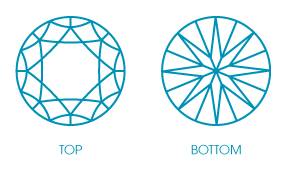
Round brilliant cut diamonds are often used for solitaire engagement rings. They have established themselves as the shape most sought after for the occasion.
Princess
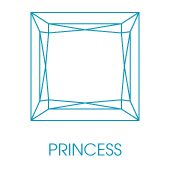 The Princess Cut Diamond, renowned for its all-out brilliance, is a square shape with sharp and uncut corners. After the Round Brilliant Cut it is the second most popular cut on the market. Although it was conceived around 1974, its popularity has gained traction since, because the faceting is very similar to the round brilliant cut. By and large Princess Cut diamonds have 76 facets, giving them great brightness and intensity. Princess cut diamonds, having sharp corners, are always designed in such ways to cover their corners, to protect them from knocks that may cause damage and chipping.
The Princess Cut Diamond, renowned for its all-out brilliance, is a square shape with sharp and uncut corners. After the Round Brilliant Cut it is the second most popular cut on the market. Although it was conceived around 1974, its popularity has gained traction since, because the faceting is very similar to the round brilliant cut. By and large Princess Cut diamonds have 76 facets, giving them great brightness and intensity. Princess cut diamonds, having sharp corners, are always designed in such ways to cover their corners, to protect them from knocks that may cause damage and chipping.
Princess cut diamonds are used for various occasions. They present themselves elegantly in a ring, particularly when complimented with smaller size princess cut diamonds on either side.
Emerald
The Emerald-Cut Diamond is renowned for its splendour and precision. As its name suggests, this cut was originally used exclusively on emeralds.
It is also known as step cut diamond, which is usually used on rectangular or square diamonds. the absence of brilliance, due to its triangular and kite-shaped facets, is compensated by its clarity.
The Emerald Diamond: A Step Cut
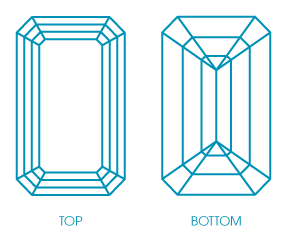
Emerald cut diamonds vary from narrow rectangle to nearly square. The typical emerald cut diamond has a length to width ratio of around 1.50. If your preference tilts towards the look of the square emerald cut diamond, you might consider the Asscher cut as well, which has a very similar appearance to the emerald cut.
An Emerald cut diamond makes a stunning engagement ring as a solitaire and blends in well with baguettes on either side or even with square cut channel set diamonds.
Asscher
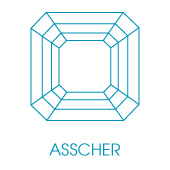 The name Asscher comes from its creator. In 1902 Joseph Asscher from Holland, following in the footsteps of his father, designed the original Asscher cut.
The name Asscher comes from its creator. In 1902 Joseph Asscher from Holland, following in the footsteps of his father, designed the original Asscher cut.
The Asscher-Cut Diamond is also called a “modified square Emerald-Cut” because it is made using the step-cut process and has cropped corners. As a result it is almost octagonal. It is vivid, sparkly, and clear in appearance. This cut offers a diminished table (the largest facet on a stone), elevated crown (top section of the stone), low pavilions (bottom portion of the stone), and cropped corners. With its 72 wide step facets it resembles that of an octagon and sparkles like the Round Brilliant cut. The Asscher cut is designed to attract your focus directly into the diamond.
The Assher cut, because of its brilliance is often used for engagement rings in a four claw setting, accompanied by a set of small diamonds on either side.
Oval
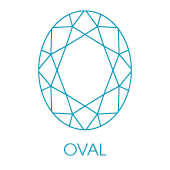 The Oval Shaped diamond was created by Lazare Kaplan in 1962. As a variation of the Round Brilliant cut, it contains 56 facets, and is full of luminosity and liveliness. The oval cut, because of its elongated shape, appears larger than a round stone of the same carat weight. it is considered a perfect alternative for a person who is after the look of the Round brilliant , but also aspiring for something distinct.
The Oval Shaped diamond was created by Lazare Kaplan in 1962. As a variation of the Round Brilliant cut, it contains 56 facets, and is full of luminosity and liveliness. The oval cut, because of its elongated shape, appears larger than a round stone of the same carat weight. it is considered a perfect alternative for a person who is after the look of the Round brilliant , but also aspiring for something distinct.
The slim shape of the Oval Diamond can give the impression that the finger is longer and slenderer, often a desired effect.
An Oval diamond makes a stunning engagement ring as a solitaire. Alternatively, it is amazing as a 3 stone ring, such as when set with 2 small round stones on either side.
Radiant
If the intensity of the Round Brilliant Cut, the popular choice for diamond engagement rings, and the shape of the Emerald Cut and Asscher Cut, are something that you fancy, then you may choose the Radiant cut diamond.
Most of the square or rectangular cut diamonds
cannot compete with the round brilliant for sparkle, however the Radiant Cut was designed specifically for getting maximum luminosity. The radiant cut diamond can be either rectangle or square, with cropped corners.
The Radiant Cut Diamond: A “Step Cut”
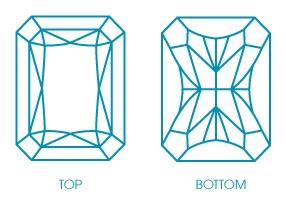
The radiant cut diamond was originally created by Henry Grossbard in 1977, this cut made squares fashionable again, giving people the chance to choose the square or rectangular shape without sacrificing the brilliance.
A radiant-cut diamond paired with either round diamonds or baguettes will bring out the lustre that you are looking for in an engagement ring.
Pear
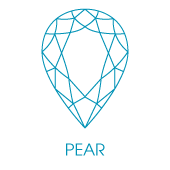 The pear Shape diamond, also called the Teardrop Shape diamond, is a variation of the Brilliant cut that contains 58 facets. Some of the world’s biggest and most legendary diamonds are Pear Shaped Diamonds.
The pear Shape diamond, also called the Teardrop Shape diamond, is a variation of the Brilliant cut that contains 58 facets. Some of the world’s biggest and most legendary diamonds are Pear Shaped Diamonds.
The Pear shape diamond is a passionate cut with plenty of glitter and vividness that gives you a sense of satisfaction in your choice.
When buying a pear shaped diamond, it is crucial to scrutinise the quality and select the highest colour grade your budget allows. The reason for this is that there may be significant issues relating to its cut.
Pear shaped diamonds, while not the traditional shape selection, make beautiful engagement rings, either as a solitaire or with round stones. It is a magnificent cut with lots of glitter and largely considered to match the brilliant cut on brilliance and the fiery look.
Heart
 Heart shape diamonds are the definitive emblem of love and are regarded as the most passionate of all diamond cuts. Based on a round brilliant cut, this cut is sometimes referred to as Modified Brilliant Heart-Shape.
Heart shape diamonds are the definitive emblem of love and are regarded as the most passionate of all diamond cuts. Based on a round brilliant cut, this cut is sometimes referred to as Modified Brilliant Heart-Shape.
When choosing a Heart shape diamond, symmetry should be a significant feature. It is essential that the two halves of the heart are matching. The wings, which are the sides as they arch down the point, should be slightly rounded shape, and the cleft, which is the curve between the two lobes, should be pointed and well-defined.
The heart shaped diamond can be quite intense with excellent glitter, and has all the necessary requirements to be considered as the ideal sentimental engagement ring, either as a solitaire or with side stones.
Marquise
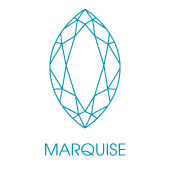 The Marquise shape diamond is a boat-like shaped stone that is a modified brilliant cut. It is considered a classic shape for engagement rings. The marquise cut diamonds have 57 facets, which are long and narrow, giving the impression of greater size. As with all ‘fancy cut’ diamonds, the two most essential virtues in this style of cut are Clarity and Colour .The Marquise is brilliant, vibrant, and has a great deal of shininess because the facets cross the length or width of the diamond and diminish, as they come closer to the top crown.
The Marquise shape diamond is a boat-like shaped stone that is a modified brilliant cut. It is considered a classic shape for engagement rings. The marquise cut diamonds have 57 facets, which are long and narrow, giving the impression of greater size. As with all ‘fancy cut’ diamonds, the two most essential virtues in this style of cut are Clarity and Colour .The Marquise is brilliant, vibrant, and has a great deal of shininess because the facets cross the length or width of the diamond and diminish, as they come closer to the top crown.
The name is derived from the Marquise of Pompadour, for whom the Sun King, king Louis XIV of France allegedly had commissioned a diamond to be cut to resemble what he considered her perfectly shaped mouth.
The allure of the marquise is that it possesses a big surface area for its weight so is a superb option if you are after a diamond with bigger appearance. This brilliant-cut diamond looks gorgeous paired with round or pear-shaped side stones, and the length of this shape makes fingers appear long and sleek.
Cushion
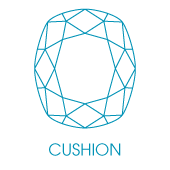 In the late 19th and early 20th centuries, The Cushion cut diamond was the diamond shape of the day. It was considered a classic and magnificent diamond. Cushion shape diamonds are also referred to as the Pillow-Cut or the Candlelight diamond, a reference to pre-electric lights era, when diamonds sparkled in the light provided by candles lights.
In the late 19th and early 20th centuries, The Cushion cut diamond was the diamond shape of the day. It was considered a classic and magnificent diamond. Cushion shape diamonds are also referred to as the Pillow-Cut or the Candlelight diamond, a reference to pre-electric lights era, when diamonds sparkled in the light provided by candles lights.
A Cushion-cut diamond has 58 facets, compared to other modern brilliant cuts, it is not as brilliant or fiery, but it possesses a classic and romantic appearance that stands out from other shape diamonds. Improvements to cushion cut diamonds over time, such as reducing the size of the culet, widening the table, and improving cut angles for greater brilliance, have led to an increase in popularity. Many consumers are attracted to the antique feel combined with modern appearance offered by the cushion cut.
Cushion cut diamond make a romantic engagement ring design. When set in four claws with smaller accentuating diamonds on either sides, Cushion cut diamonds can become part of your dream engagement ring.